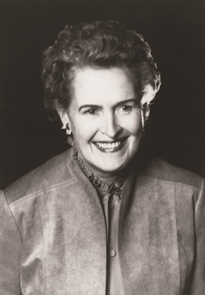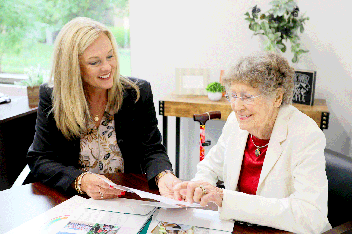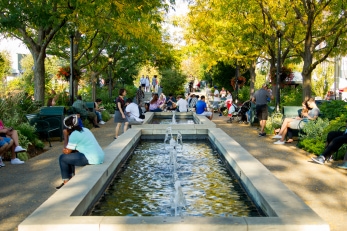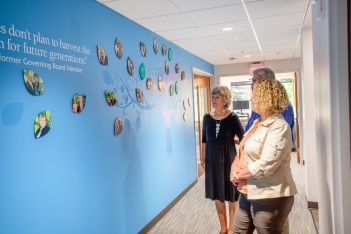
Several decades ago - when the old boys’ network was king, spokespersons were always spokesmen, and a woman’s corporate presence was more decorative than decisive - Anne Greene emerged as a community leader.
Born with the strength to command and lead, Mrs. Greene was a philanthropist and self-proclaimed “professional volunteer” for more than 50 years for dozens of civic, human relations, arts, cultural and health care organizations in the Miami Valley.
“Anne was a clear trailblazer in an era that’s difficult to understand now,” said Frederick C. Smith, emeritus member and former chair of The Dayton Foundation Governing Board. “She earned and accepted leadership positions and was invited to participate in discussions previously reserved for men. ”
Mrs. Greene accomplished a number of firsts for Miami Valley women: in 1975, first woman board president of United Way of the Greater Dayton Area; in 1978, first woman director of the Dayton Area Chamber of Commerce; and in 1979, first woman director of First National Bank, now National City Bank. In 1980, she became the first woman on The Dayton Foundation’s Governing Board and served there for 10 years.
Mrs. Greene brought something new to Miami Valley boardrooms. “Estrogen!” said Frederick Bartenstein, III, a former director of The Dayton Foundation, “and most certainly her credibility and her community connections. If Anne Greene said something was important, folks listened.”
Mrs. Greene, who died in May at age 83, was remembered as a businesswoman who exuded dignity, grace and a grand, commanding presence.
“Because of Anne’s legacy, community leaders quickly recognized that there’s no reason to put a third-grade man on the board when you can get a first-class woman,” Smith said.
She served as a board member for Miami Valley Hospital, Planned Parenthood of Miami Valley and Victoria Theatre, among many others. She also served as chair of Arts Dayton and Dayton’s Human Relations Commission and chair and co-founder of the Performing Arts Board, now CultureWorks, among other top leadership positions.
“Mrs. Greene believed volunteers are a community’s strength,” said Michael M. Parks, president of The Dayton Foundation. “In addition to her time and treasure, she contributed her intellect, her thoughtful deliberation and her strategic thinking to difficult community problems.”
As a role model and mentor, Mrs. Greene was quick to bring other women along with her or to the attention of corporate leaders in the community, said Paula J. MacIlwaine, a former Montgomery County commissioner and retired CEO who serves on the Foundation’s Governing Board. “I definitely wouldn’t have done some of the things I did without looking to her for advice. She was the one person I called whenever I wanted an opinion on things. She had a good fix on politics, how the community worked and how to work with business leaders,” MacIlwaine said.
John E. Moore, an emeritus Governing Board member who served with Mrs. Greene, said she was always effective, whether chairing a board or serving as a board member. “She asked the penetrating questions that others often did not raise, and at the same time, she was a good listener,” he said. “She wasn’t one quick to go with the crowd.”
But she was quick to take the reins at the Victory Theatre in 1980, when it was close to bankruptcy. Bartenstein said he and Mrs. Greene worked as a team “very desperately” to raise funds and turn the theater around by 1981. Then in 1984, she agreed to serve as the Victoria’s interim managing director - full time and without pay - after the director at that time resigned. She gave two years of her life, but enjoyed the job immensely, Bartenstein said.
“She was perfectly willing to step out front personally and do all the hard work required to make a difference,” Smith said. This was evident when Mrs. Greene, a leader in race relations in her day, agreed to chair the Dayton Human Relations Commission in 1964. It was a racially tense time in the city’s history.
“She felt strongly that there were no ‘bests’ and no ‘betters,’ and that everyone should be dealt with equally,” said Sue Williams, Mrs. Greene’s daughter-in-law. “She got involved, because it was the right thing to do.”
Mrs. Greene gave generously and often anonymously, dispersing her financial resources widely, rather than focusing on only a handful of not-for-profits. “Her interpretation of community was everything from Adopt-A-Dancer to the First National Bank board,” Williams said. “She saw the community as a quilt made up of diverse groups with diverse needs that somebody has to sew together.”
Cincinnati born and bred and the oldest of five children, Anne Sawyer Greene attended Vassar College and the University of Cincinnati. She came to Dayton in 1945 and lived here the rest of her life. She was the daughter of Margaret Johnston and Charles Sawyer, and, through her mother, was an heiress to the Procter & Gamble fortune. Her father was an attorney and founder of Great Trails Broadcasting Company. He had been Ohio lieutenant governor in 1938, ambassador to Belgium in 1944 and President Truman’s Secretary of Commerce.
Over the years, she and her husband, John B. Greene, an investment broker, gave more than $423,000 through two Dayton Foundation funds: The Mr. and Mrs. John B. Greene Fund, established in 1988 to provide unrestricted funds to meet changing community needs, and the John and Anne Greene Fund, established in 1996 to benefit various charitable organizations.
Together the Greenes raised eight children and enjoyed numerous grandchildren and great-grandchildren. “She was the first person her children and grandchildren would go to for advice,” Williams said. “She was the center of their wheel, and she loved it.”
Moore called her “a class lady - a dynamic, independent spirit and a friend. It was a great honor to have had the opportunity to work with her.”








